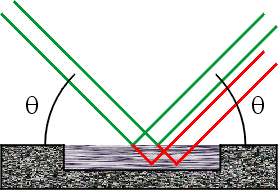 |
Transparency |
 |
Transparency |
Transparency
For the Bragg-Brentano geometry, poor data may be obtained when the sample is too transparent for X-rays. This situation is common for organic materials containing only light elements such as C, H, N, and O. For transparent samples, the X-rays penetrate deeper into the sample than normal as shown in the figure below:

The green lines represent the path of the X-rays when the diffraction is from the surface layer, while the red lines show the path of the X-rays for diffraction well below the surface. The Bragg angles of the scattered X-rays are the same in each case, but the path of the X-rays shown by the red lines will be seen by the detector at a slightly smaller 2θ angle than those represented by the green lines.
The effect of sample transparency on the powder diffraction data is illustrated below using the saccharide glucose (which has the chemical formula C6H12O6):


Under these circumstances, maybe the best way to collect data for multi-purpose use is to exploit transmission geometry, which is ideal for organic materials with low absorption.
|
© Copyright 1997-2006.
Birkbeck College, University of London.
|
Author(s):
Jeremy Karl Cockcroft Martin Vickers |